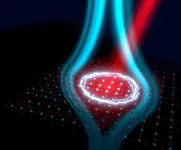(Press-News.org) Researchers created a computer model that uses AI to examine heart images from magnetic resonance imaging (MRI)
Results were comparable to those worked out by doctors manually, but instead of taking 45 minutes or more, the AI model takes just a few seconds
The AI model could lead to more efficient diagnoses, better treatment decisions and improved outcomes for patients
Researchers have developed a groundbreaking method for analysing heart MRI scans with the help of artificial intelligence, which could save valuable NHS time and resources, as well as improve care for patients.
The teams from the Universities of East Anglia (UEA), Sheffield and Leeds created an intelligent computer model that utilises AI to examine heart images from MRI scans in a specific view known as the four-chamber plane.
Lead researcher Dr Pankaj Garg, of the University of East Anglia’s Norwich Medical School and a consultant cardiologist at the Norfolk and Norwich University Hospital, heads up a team of researchers who have pioneered innovative and revolutionary 4D MRI imaging technology. This is paving the way for faster, non-invasive and more accurate diagnosis of heart failure and other cardiac conditions.
Dr Garg said: “The AI model precisely determined the size and function of the heart's chambers and demonstrated outcomes comparable to those acquired by doctors manually but much quicker.
“Unlike a standard manual MRI analysis, which can take up to 45 minutes or more, the new AI model takes just a few seconds.
“This automated technique could offer speedy and dependable evaluations of heart health, with the potential to enhance patient care.”
The retrospective observational study consisted of data from 814 patients from Sheffield Teaching Hospitals NHS Foundation Trust and Leeds Teaching Hospitals NHS Trust, which was then used to train the AI model.
To make sure the model’s results were accurate, scans and data from another 101 patients from the Norfolk and Norwich University Hospitals NHS Foundation Trust were then used for testing.
While other studies have investigated the use of AI in interpreting MRI scans, this latest AI model was trained using data from multiple hospitals and different types of scanners, as well as conducting the testing on a diverse group of patients from a different hospital. In addition, this AI model provides a complete analysis of the entire heart using a view that shows all four chambers, while most earlier studies focused on a view that only looks at the heart's two main chambers.
PhD student Dr Hosamadin Assadi, of UEA’s Norwich Medical School, said: “Automating the process of assessing heart function and structure will save time and resources and ensure consistent results for doctors.
“This innovation could lead to more efficient diagnoses, better treatment decisions, and ultimately, improved outcomes for patients with heart conditions.
“Moreover, the potential of AI to predict mortality based on heart measurements highlights its potential to revolutionise cardiac care and improve patient prognosis.”
The researchers say future studies should test the model using larger groups of patients from different hospitals, with various types of MRI scanners, and including other common diseases seen in medical practice to see if it works well in a broader range of real-world situations.
Other recent research from the teams at UEA, Leeds and Sheffield has refined the method of using heart MRI scans for female patients, particularly for those with early or borderline heart disease, which meant that 16.5pc more females were able to be diagnosed.
The research was a collaboration between the University of East Anglia, the University of Leeds, the University of Sheffield, Leiden University Medical Centre, the Norfolk and Norwich University Hospitals NHS Foundation Trust, Sheffield Teaching Hospitals NHS Foundation Trust and Leeds Teaching Hospitals NHS Trust.
The study was supported by funding for Dr Pankaj Garg from the Wellcome Trust Clinical Research Career Development Fellowship.
'Development and validation of AI-derived segmentation of four-chamber cine CMR' is published in the European Radiology Experimental.
END
Artificial intelligence speeds up heart scans, saving doctors’ time, and could lead to better treatment for heart conditions
2024-07-12
ELSE PRESS RELEASES FROM THIS DATE:
How the 'heart and lungs' of a galaxy extend its life
2024-07-12
Galaxies avoid an early death because they have a "heart and lungs" which effectively regulate their "breathing" and prevent them growing out of control, a new study suggests.
If they didn't, the Universe would have aged much faster than it has and all we would see today is huge "zombie" galaxies teeming with dead and dying stars.
That’s according to a new study published in the Monthly Notices of the Royal Astronomical Society, which investigates one of the great mysteries of the Universe – why galaxies are not ...
Light-induced Meissner effect in optically driven YBa2Cu3O6.48
2024-07-12
Superconductivity is a fascinating phenomenon, which allows a material to sustain an electrical current without any loss. This collective quantum behavior of matter only appears in certain conductors at temperatures far below ambient.
A number of modern studies have investigated this behavior in so-called non-equilibrium states, that is in situations in which the material is pushed away from thermal equilibrium. In these conditions, it appears that at least some of the features of superconductivity can be recreated even at ambient temperatures. Such non-equilibrium high temperature superconductivity, shown to exist under irradiation ...
Study finds short and long sleep duration associated with blood vessel damage in those recently diagnosed with type 2 diabetes
2024-07-12
New research to be presented at this year’s Annual Meeting of the European Association for the Study of Diabetes (EASD) (Madrid, 9-13 September) shows that people recently diagnosed with diabetes who experience short or long sleep duration are more likely to experience microvascular disease (damage to the small blood vessels), which could ultimately lead to more serious complications. The study is by Mette Johansen and Thomas Olesen, Steno Diabetes Center Odense, Odense University Hospital, Odense, Denmark, and colleagues.
Microvascular complications, such as retinopathy and nephropathy, are major contributors ...
IoT sensors tattle on stores that neglect promo displays
2024-07-11
Whether it’s a pharmacy, a supermarket, or a clothier, when you walk into a retail store in the U.S., you are sure to encounter a flashy promotional display featuring products from a specific brand.
It’s a marketing strategy that’s been proved to be highly effective at boosting sales. Brands carefully plan display campaigns, signing contracts with retailers that specify when to install the exhibits and for how long. They often provide financial incentives to encourage compliance.
But a new study from Ashish ...
A stealth fungus has decimated North American bats but scientists may be a step closer to treating white-nose syndrome
2024-07-11
An invasive fungus that colonizes the skin of hibernating bats with deadly consequences is a stealthy invader that uses multiple strategies to slip into the small mammals' skin cells and quietly manipulate them to aid its own survival. The fungus, which causes the disease white-nose syndrome, has devastated several North American species over the last 18 years.
Scientists have learned much about the fungus, Pseudogymnoascus destructans, since it was first documented in a New York cave in 2006, including where it thrives, its distribution, and clinical features. But exactly ...
Menstrual cramps can be worse in normal-length cycles without ovulation
2024-07-11
According to current understanding, menstrual cramps only happen in cycles in which an egg is released, or an ovulatory cycle. But new research from the University of British Columbia (UBC) is challenging this notion.
The findings, published in the Journal of Pain Research, reveal that some women not only experience cramps when no egg is released, but that cramps can be more severe and last longer during these anovulatory cycles.
“I was surprised to see significant cramps in menstrual cycles with or without ovulation, which challenges current thinking” said co-author, Dr. Paul Yong, associate professor of obstetrics and gynecology at UBC and Canada Research ...
Racial disparities in dementia determined by social factors
2024-07-11
Racial disparities in dementia are due to social determinants of health, with genetic ancestry playing no role, according to a new study led by researchers at Washington University School of Medicine in St. Louis.
The study, which was based on a long-running population-based survey in four Latin American countries, helps explain why people of predominantly Native American or African ancestry have a higher prevalence of dementia: Study participants were more likely to experience social contexts and health conditions that raised their risk of cognitive decline, such as lower education levels, rural residency and high blood pressure. Once such factors ...
Rice engineers’ probe could help advance treatment for spinal cord disease, injury
2024-07-11
HOUSTON – (July 11, 2024) – Implantable technologies have significantly improved our ability to study and even modulate the activity of neurons in the brain, but neurons in the spinal cord are harder to study in action.
“If we understood exactly how neurons in the spinal cord process sensation and control movement, we could develop better treatments for spinal cord disease and injury,” said Yu Wu, a research scientist who is part of a team of Rice University neuroengineers working on a solution to this problem.
“We developed a tiny sensor, spinalNET, that records the electrical activity of spinal neurons as the subject performs normal ...
Muscle machine: How water controls the speed of muscle contraction
2024-07-11
Image
The flow of water within a muscle fiber may dictate how quickly muscle can contract, according to a University of Michigan study.
Nearly all animals use muscle to move, and it's been known for a long time that muscle, like all other cells, is composed of about 70% water. But researchers don't know what sets the range and upper limits of muscle performance. Previous research into how muscle works focused only on how it worked on a molecular level rather than how muscle fibers are shaped, that they are three-dimensional ...
Nearly one in 10 pregnant people who get COVID will develop long COVID
2024-07-11
Nearly one in 10 people who get COVID while pregnant will go on to develop long COVID, a report publishing July 11th in Obstetrics & Gynecology has found.
“It was surprising to me that the prevalence was that high,” says Torri Metz, MD, vice chair of research of obstetrics and gynecology at University of Utah Health, who co-led the nationwide study. “This is something that does continue to affect otherwise reasonably healthy and young populations.”
Intersecting risks
Prior research had shown that COVID affects pregnant people in uniquely ...





